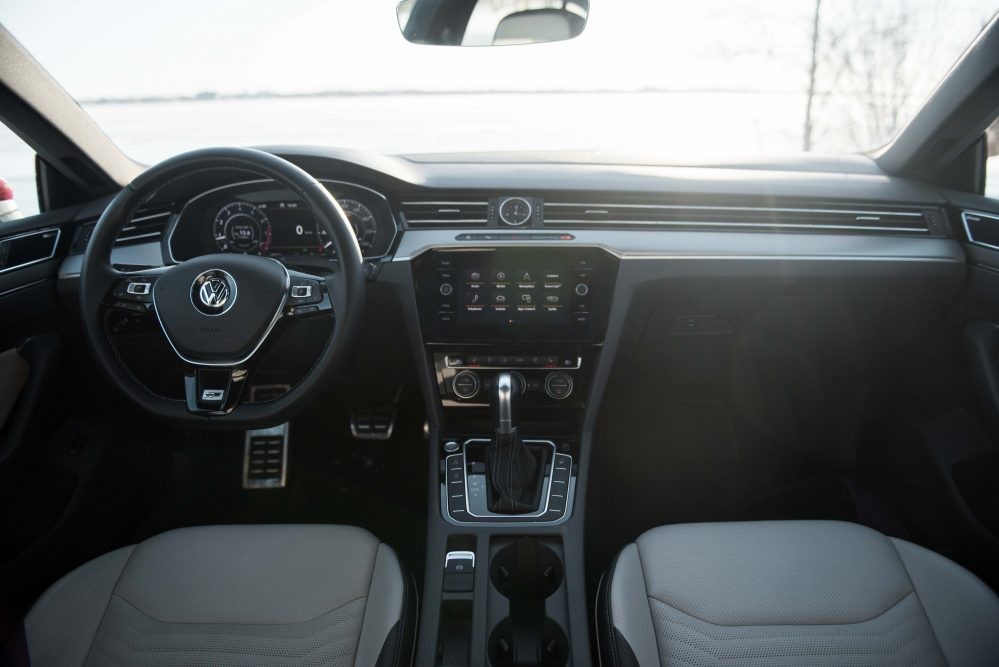Vcds Arteon, also known as VAG-COM Diagnostic System, is your gateway to unlocking the full potential of your Volkswagen Arteon. With enhanced diagnostics, personalized settings, and powerful adaptations, VCDS Arteon empowers you to take control of your vehicle. Discover how CARDIAGTECH.NET can help you maximize your Arteon’s performance and features with the right VCDS tools. Explore advanced diagnostics, custom coding options, and performance tuning capabilities today.
1. Understanding VCDS for Your Arteon
VCDS, or VAG-COM Diagnostic System, is a powerful software and hardware combination that allows you to communicate with the various electronic control units (ECUs) in your Volkswagen Arteon. This tool goes far beyond basic OBD-II scanners, offering in-depth diagnostics, coding, and adaptation capabilities. It’s like having a factory-level scan tool at your fingertips.
1.1. What is VCDS?
VCDS, developed by Ross-Tech, is a diagnostic tool specifically designed for Volkswagen, Audi, Skoda, and SEAT vehicles (collectively known as VAG). It consists of a software application that runs on a Windows PC and a special interface cable that connects your computer to the car’s OBD-II port.
1.2. Why Use VCDS on Your Arteon?
Using VCDS on your Arteon offers numerous advantages:
- Advanced Diagnostics: Read and clear diagnostic trouble codes (DTCs) from all modules, not just the engine. This helps you identify and troubleshoot issues quickly and accurately.
- Customization: Enable or disable various features and settings to personalize your Arteon to your liking.
- Adaptations: Adjust settings to optimize performance, improve fuel economy, or adapt to specific modifications.
- Data Logging: Record real-time data from various sensors to analyze performance and diagnose problems.
- Component Testing: Perform output tests to activate individual components and verify their functionality.
1.3. Key Features of VCDS
VCDS boasts a wide array of features that make it an indispensable tool for Arteon owners and technicians:
| Feature | Description |
|---|---|
| DTC Reading/Clearing | Reads and clears diagnostic trouble codes (DTCs) from all modules in the vehicle. |
| Live Data Monitoring | Displays real-time data from various sensors and components, allowing you to monitor performance and diagnose issues. |
| Adaptation | Allows you to adjust settings and parameters within various modules to customize vehicle behavior and optimize performance. |
| Coding | Enables you to enable or disable features, change settings, and personalize your vehicle to your preferences. |
| Output Tests | Performs output tests to activate individual components and verify their functionality. |
| Readiness Tests | Checks the status of various emission-related systems to ensure they are ready for an emissions test. |
| Guided Functions | Provides step-by-step instructions for performing specific tasks, such as resetting service reminders or calibrating sensors. |
| Oscilloscope Function | Allows you to view electrical signals in real-time, aiding in the diagnosis of electrical problems. |
| Advanced Measuring Values | Accesses more detailed and specific data parameters compared to standard measuring blocks. |
| Control Module Maps | Creates a detailed map of the control module’s settings and adaptations, allowing for easier documentation and comparison. |




1.4. VCDS vs. OBD-II Scanners
While basic OBD-II scanners can read and clear engine-related DTCs, VCDS offers a much deeper level of access and functionality. Here’s a comparison:
| Feature | VCDS | OBD-II Scanner |
|---|---|---|
| Module Access | All modules | Engine only (usually) |
| Coding/Adaptation | Yes | No |
| Live Data | Extensive parameters | Limited parameters |
| Output Tests | Yes | No |
| Guided Functions | Yes | No |
| Vehicle Coverage | VAG-specific | Generic (all OBD-II compliant vehicles) |
| Cost | Higher initial cost | Lower initial cost |
| Ideal For | VAG enthusiasts, technicians, tuners | Basic diagnostics, code reading/clearing |
An essential VCDS cable, connecting your car to diagnostic possibilities.
2. Essential VCDS Tweaks for Your Arteon
VCDS allows you to perform a variety of tweaks and customizations on your Arteon. Here are some of the most popular and useful options:
2.1. Enabling Hidden Features
Many modern cars, including the Arteon, have hidden features that are disabled from the factory. VCDS can unlock these features, enhancing your driving experience.
- Coming Home/Leaving Home Lights: Activate the headlights, taillights, and fog lights when unlocking or locking the car for improved visibility.
- Cornering Fog Lights: Turn on the fog light on the side you’re turning towards for better illumination in corners.
- Emergency Braking Flashing: Automatically activate the hazard lights during hard braking to warn other drivers.
- Gauge Staging (Needle Sweep): Make the gauge needles sweep to their maximum position and back when starting the car for a sporty look.
- Windows Up/Down with Remote: Control the windows with the remote key fob for added convenience.
2.2. Comfort and Convenience Settings
Adjust various settings to improve your comfort and convenience:
- Seatbelt Warning: Disable or adjust the seatbelt warning chime.
- Rain Closing: Automatically close the windows and sunroof if rain is detected while the car is parked.
- Mirror Dip on Reverse: Automatically tilt the passenger side mirror down when reversing for better visibility of the curb.
- Lane Assist Sensitivity: Adjust the sensitivity of the lane keeping assist system.
- ACC (Adaptive Cruise Control) Behavior: Modify the ACC system’s acceleration and braking characteristics.
2.3. Performance and Drivetrain Adjustments
VCDS can also be used to make subtle adjustments to the Arteon’s performance and drivetrain:
- Throttle Response: Improve throttle response for a more engaging driving experience.
- Launch Control: Enable launch control for quicker acceleration from a standstill (if applicable).
- XDS (Electronic Differential Lock) Strength: Adjust the strength of the XDS system for improved handling in corners.
- Soundaktor Volume: Adjust or disable the soundaktor, which artificially enhances the engine sound in the cabin.
- Steering Assist Level: Change the level of power steering assistance for a sportier or more comfortable feel.
2.4. Safety and Security Enhancements
Improve the safety and security features of your Arteon:
- Alarm System Customization: Adjust the sensitivity of the alarm system or add additional features.
- Automatic Door Locking: Configure the doors to automatically lock when reaching a certain speed.
- High Beam Assist Delay: Adjust the delay before the high beam assist system activates.
- Tire Pressure Monitoring System (TPMS) Calibration: Recalibrate the TPMS after changing tire pressures or rotating tires.
- Rain Light Activation: Adjust the sensitivity of the automatic headlight activation based on rain.
Customize the interior lighting and functionality of your Arteon with VCDS.
3. Step-by-Step Guide to Using VCDS with Your Arteon
Using VCDS may seem daunting at first, but with a little guidance, it’s a straightforward process. Here’s a step-by-step guide:
3.1. What You’ll Need
- A Windows PC (laptop recommended)
- A VCDS interface cable (available from Ross-Tech or authorized dealers like CARDIAGTECH.NET)
- The VCDS software (downloadable from Ross-Tech’s website)
- Your Volkswagen Arteon
3.2. Installation and Setup
- Download the VCDS Software: Go to the Ross-Tech website and download the latest version of the VCDS software.
- Install the Software: Run the downloaded file and follow the on-screen instructions to install VCDS on your PC.
- Connect the Interface Cable: Plug the VCDS interface cable into a USB port on your PC.
- Install the USB Drivers: The software will prompt you to install the USB drivers for the interface cable. Follow the instructions to complete the driver installation.
- Test the Interface: Open the VCDS software and go to “Options.” Select the correct COM port for your interface cable and click “Test.” If the test is successful, you’re ready to go.
3.3. Connecting to Your Arteon
- Locate the OBD-II Port: The OBD-II port is typically located under the dashboard on the driver’s side.
- Plug in the Cable: Plug the VCDS interface cable into the OBD-II port.
- Turn on the Ignition: Turn the ignition key to the “on” position, but don’t start the engine.
- Launch VCDS: Open the VCDS software on your PC.
- Select Control Module: Click “Select” and choose the control module you want to access (e.g., Engine, Transmission, ABS).
3.4. Performing Common Tasks
- Reading DTCs: Select the control module, click “Fault Codes,” and then “Read Codes.” The software will display any stored DTCs.
- Clearing DTCs: After reading the DTCs, click “Clear Codes” to erase them from the module’s memory.
- Adaptation: Select the control module, click “Adaptation,” enter the adaptation channel number, and then enter the new value.
- Coding: Select the control module, click “Coding,” and then use the long coding helper to modify the coding string.
- Live Data: Select the control module, click “Measuring Blocks,” and then select the data parameters you want to monitor.
3.5. Important Safety Precautions
- Backup Your Settings: Before making any changes, always back up the original coding and adaptation values. This allows you to revert to the original settings if something goes wrong.
- Double-Check Your Work: Carefully review all changes before saving them to the control module.
- Use Reliable Information: Only use coding and adaptation information from trusted sources, such as Ross-Tech’s website or reputable forums.
- Be Aware of Potential Risks: Incorrect coding or adaptation can cause malfunctions or damage to your vehicle. Proceed with caution and at your own risk.
- Battery Voltage: Ensure your car’s battery is fully charged before performing any coding or adaptation, as voltage drops can interrupt the process and cause errors.
4. Advanced VCDS Applications for the Arteon
Beyond basic tweaks, VCDS can be used for more advanced applications:
4.1. Performance Tuning
VCDS can be used to fine-tune various engine parameters for improved performance. However, it’s important to note that modifying these settings can void your warranty and may not be legal in all areas.
- Boost Control: Adjust boost levels for increased power (requires supporting modifications).
- Timing Advance: Optimize ignition timing for better combustion and power.
- Fueling Adjustments: Fine-tune the air-fuel ratio for optimal performance.
4.2. Diagnostics and Troubleshooting
VCDS is an invaluable tool for diagnosing and troubleshooting complex issues:
- Component Testing: Perform output tests to activate individual components, such as fuel injectors or solenoids, to verify their functionality.
- Data Logging: Record real-time data from various sensors to analyze performance and identify anomalies.
- Fault Code Analysis: Use the detailed fault code information provided by VCDS to pinpoint the root cause of problems.
4.3. Module Retrofitting
VCDS can be used to code and adapt new modules to your Arteon, such as:
- Navigation System: Retrofit a factory navigation system and code it to work with the car’s existing electronics.
- Backup Camera: Install a backup camera and code it to display the image on the infotainment screen.
- Adaptive Cruise Control: Add adaptive cruise control and code it to integrate with the car’s other systems.
- Lane Assist: Retrofit lane assist and code it to function correctly.
- Parking Sensors: Install front and rear parking sensors and code them to integrate with the car’s display.
4.4. Immobilizer and Key Programming
VCDS can be used for some basic immobilizer functions and key programming, but it’s important to note that these functions are limited and require special procedures.
- Key Adaptation: Adapt new keys to the immobilizer system.
- Immobilizer Status: Check the status of the immobilizer system.
- Component Protection: Remove component protection from certain modules (requires online access).
Diagnose and optimize the performance of your Arteon’s lighting system with VCDS.
5. Choosing the Right VCDS Cable for Your Arteon
Selecting the right VCDS cable is crucial for ensuring proper functionality and compatibility. Here’s what to consider:
5.1. Cable Types
- HEX-V2: The latest generation VCDS interface cable, offering the fastest communication speeds and support for the latest VAG vehicles. Recommended for Arteon owners.
- Micro-CAN: A legacy interface cable that supports older VAG vehicles. Not recommended for the Arteon.
5.2. Genuine vs. Clone Cables
- Genuine Cables: Purchased from Ross-Tech or authorized dealers, offering full functionality, software updates, and technical support. CARDIAGTECH.NET is your trusted partner.
- Clone Cables: Illegal copies of the genuine cables, often with limited functionality, no software updates, and no technical support. Using clone cables can damage your car’s electronics.
5.3. Considerations When Purchasing
- Vehicle Compatibility: Ensure the cable is compatible with your Arteon’s model year.
- Software Updates: Check if the cable supports free software updates.
- Technical Support: Verify that the seller offers technical support in case you encounter any issues.
- Warranty: Look for a cable with a warranty to protect against defects.
6. VCDS Coding Examples for the Arteon
Here are some specific VCDS coding examples for the Volkswagen Arteon. These examples are for informational purposes only, and you should proceed with caution and at your own risk. Always back up your original coding before making any changes.
6.1. Enabling Coming Home/Leaving Home Lights
- Module: 09 – Central Electronics
- Coding:
- Byte 0: Bit 0 – Activate Coming Home
- Byte 0: Bit 1 – Activate Leaving Home
- Adaptation:
- Channel: Coming Home Time – Set the desired duration (e.g., 10 seconds)
- Channel: Leaving Home Time – Set the desired duration (e.g., 10 seconds)
6.2. Enabling Cornering Fog Lights
- Module: 09 – Central Electronics
- Coding:
- Byte 23: Bit 6 – Activate Cornering Fog Lights
- Adaptation:
- Channel: Cornering Light Speed Threshold – Set the minimum speed for activation (e.g., 40 km/h)
6.3. Adjusting Lane Assist Sensitivity
- Module: A5 – Front Sensors Driver Assistance System
- Adaptation:
- Channel: Road Edge Recognition Configuration – Adjust the sensitivity level (e.g., Early, Medium, Late)
6.4. Disabling Soundaktor (Engine Sound Enhancer)
- Module: A9 – Structure Borne Sound
- Adaptation:
- Channel: Volume of Structure Borne Sound – Set the value to 0%
6.5. Enabling Gauge Staging (Needle Sweep)
- Module: 17 – Instruments
- Coding:
- Byte 1: Bit 0 – Activate Gauge Staging
Improve your Arteon’s driving dynamics and personalize its performance with VCDS.
7. Maintaining and Updating Your VCDS Software
Keeping your VCDS software up-to-date is essential for ensuring compatibility with the latest vehicle models and accessing the newest features and bug fixes.
7.1. Checking for Updates
- Automatic Updates: VCDS can be configured to automatically check for updates when the software is launched.
- Manual Updates: You can also manually check for updates by going to the “About” section of the VCDS software and clicking “Check for Updates.”
7.2. Installing Updates
- Follow the Instructions: When an update is available, follow the on-screen instructions to download and install it.
- Restart the Software: After the update is complete, restart the VCDS software for the changes to take effect.
7.3. Keeping Your Cable Firmware Updated
- Firmware Updates: Occasionally, Ross-Tech may release firmware updates for the VCDS interface cable. These updates improve performance and compatibility.
- Follow the Instructions: The VCDS software will prompt you to install firmware updates when they are available. Follow the on-screen instructions to complete the update process.
8. Common Issues and Troubleshooting Tips
Even with careful use, you may encounter issues while using VCDS. Here are some common problems and troubleshooting tips:
8.1. Cable Not Recognized
- Check USB Connection: Ensure the VCDS interface cable is securely plugged into a USB port on your PC.
- Reinstall USB Drivers: Try reinstalling the USB drivers for the interface cable.
- Test the Interface: Use the “Test” function in the VCDS options to verify that the software can communicate with the cable.
- Try a Different USB Port: Try using a different USB port on your PC.
- Check Cable LED: Make sure the LED on the cable is illuminated, indicating that it’s receiving power.
8.2. Cannot Connect to Control Module
- Check Ignition: Ensure the ignition key is in the “on” position.
- Check OBD-II Connection: Make sure the VCDS interface cable is securely plugged into the OBD-II port.
- Verify Vehicle Compatibility: Ensure the VCDS software and cable are compatible with your Arteon’s model year.
- Try a Different Module: Try connecting to a different control module to see if the issue is specific to one module.
- Check for Fault Codes: Use a basic OBD-II scanner to check for any fault codes that may be preventing communication with the module.
8.3. Coding or Adaptation Errors
- Double-Check Values: Carefully review the coding and adaptation values before saving them to the control module.
- Use Reliable Information: Only use coding and adaptation information from trusted sources.
- Backup Your Settings: Always back up the original coding and adaptation values before making any changes.
- Battery Voltage: Ensure your car’s battery is fully charged before performing any coding or adaptation.
- Try Again: Sometimes, coding or adaptation errors can occur due to temporary glitches. Try repeating the process.
8.4. Software Crashes or Freezes
- Update VCDS: Make sure you’re using the latest version of the VCDS software.
- Close Other Programs: Close any other programs that may be running in the background.
- Restart Your PC: Try restarting your PC.
- Reinstall VCDS: Try reinstalling the VCDS software.
- Check System Requirements: Ensure your PC meets the minimum system requirements for VCDS.
9. The Future of VCDS and the Arteon
VCDS continues to evolve with new features and capabilities, ensuring it remains a valuable tool for Arteon owners and technicians. Ross-Tech is committed to providing ongoing support and updates for VCDS, ensuring compatibility with the latest VAG vehicles. As the Arteon evolves with new technologies and features, VCDS will adapt to meet the changing diagnostic and customization needs of its users. Expect to see continued improvements in areas such as:
- Cloud Connectivity: Integration with cloud-based services for data logging, analysis, and remote diagnostics.
- Artificial Intelligence: AI-powered diagnostics and troubleshooting assistance.
- Expanded Module Support: Support for new and emerging vehicle technologies.
- Enhanced User Interface: More intuitive and user-friendly software interface.
The Volkswagen Arteon: A modern car that can be boosted with VCDS.
10. Why Choose CARDIAGTECH.NET for Your VCDS Needs?
When it comes to purchasing VCDS tools and accessories, choosing a reliable and reputable supplier is crucial. CARDIAGTECH.NET offers several advantages:
- Genuine Products: We only sell genuine VCDS interface cables from Ross-Tech, ensuring full functionality and compatibility.
- Competitive Pricing: We offer competitive prices on all our VCDS products.
- Expert Support: Our knowledgeable staff can provide expert advice and support to help you choose the right VCDS tools for your needs.
- Fast Shipping: We offer fast and reliable shipping to get you up and running quickly.
- Excellent Customer Service: We are committed to providing excellent customer service and support.
Don’t settle for less when it comes to diagnosing and customizing your Volkswagen Arteon. Choose CARDIAGTECH.NET for all your VCDS needs.
Ready to unlock the full potential of your Volkswagen Arteon? Contact CARDIAGTECH.NET today for expert advice and support on choosing the right VCDS tools for your needs.
Address: 276 Reock St, City of Orange, NJ 07050, United States
Whatsapp: +1 (641) 206-8880
Website: CARDIAGTECH.NET
Frequently Asked Questions (FAQ) about VCDS Arteon
- What is VCDS and how does it work with my Arteon?
- VCDS (VAG-COM Diagnostic System) is a software and hardware tool that allows you to communicate with your Volkswagen Arteon’s electronic control units (ECUs) for diagnostics, coding, and adaptations.
- Is VCDS safe to use on my Arteon?
- Yes, when used correctly. Always back up your original settings, use reliable information, and proceed with caution.
- Where can I purchase a genuine VCDS cable for my Arteon?
- You can purchase genuine VCDS cables from Ross-Tech or authorized dealers like CARDIAGTECH.NET.
- Can VCDS void my Arteon’s warranty?
- Modifying certain settings with VCDS can potentially void your warranty. Check with your dealer for clarification.
- What are some common VCDS tweaks I can perform on my Arteon?
- Common tweaks include enabling coming home/leaving home lights, cornering fog lights, adjusting lane assist sensitivity, and disabling the soundaktor.
- How do I update my VCDS software?
- VCDS can be configured to automatically check for updates, or you can manually check for updates in the “About” section of the software.
- What should I do if I encounter an error while using VCDS?
- Double-check your connections, verify vehicle compatibility, use reliable information, and try again. Consult the VCDS documentation or seek help from online forums.
- Can VCDS be used to improve my Arteon’s performance?
- Yes, VCDS can be used to fine-tune various engine parameters for improved performance, but this requires advanced knowledge and should be done with caution.
- Is VCDS compatible with all Arteon models?
- VCDS is compatible with most Arteon models, but always verify compatibility before purchasing a cable.
- Do I need any special skills to use VCDS?
- Basic computer skills and a willingness to learn are helpful. Some advanced functions may require more technical knowledge.
